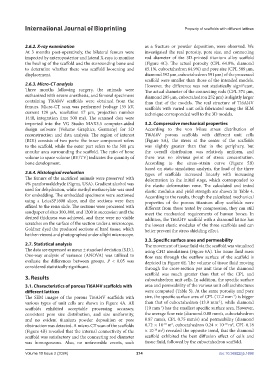Page 222 - IJB-10-2
P. 222
International Journal of Bioprinting Property of scaffolds with different lattices
2.6.2. X-ray examination as a fracture or powder deposition, were observed. We
At 3 months post-operatively, the bilateral femurs were investigated the real porosity, pore size, and connecting
inspected by anteroposterior and lateral X-rays to monitor rod diameter of the 3D-printed titanium alloy scaffold
the healing of the scaffold and the surrounding bone and (Figure 4C). The actual porosity (CPL 64.8%, diamond
to determine whether there was scaffold loosening and 65.1%, cuboctahedron 64.9%) and pore size (CPL 589 µm,
displacement. diamond 592 µm, cuboctahedron 591 µm) of the processed
scaffold were smaller than those of the intended models.
2.6.3. Micro-CT analysis However, the difference was not statistically significant.
Three months following surgery, the animals were The actual diameter of the connecting rods (CPL 371 µm,
euthanized with severe anesthesia, and femoral specimens diamond 205 µm, cuboctahedron 252 µm) is slightly larger
containing Ti6Al4V scaffolds were obtained from the than that of the models. The real structure of Ti6Al4V
femurs. Micro-CT scan was performed (voltage 155 kV, scaffolds with varied unit cells fabricated using the SLM
current 120 µA, resolution 17 µm, projection number technique corresponded well to the 3D models.
1440, integration time 500 ms). The scanned data were
imported into the VG Studio MAX3.5 computer-aided 3.2. Compressive mechanical properties
design software (Volume Graphics, Germany) for 3D According to the von Mises stress distribution of
reconstruction and data analysis. The region of interest Ti6Al4V porous scaffolds with different unit cells
(ROI) consists of two parts: the inner component refers (Figure 5A), the stress at the center of the scaffolds
to the scaffold, while the outer part refers to the 500 μm was slightly greater than that in the periphery, but
annular area surrounding the scaffold. The ratio of bone the overall distribution was relatively uniform, and
volume to space volume (BV/TV) indicates the quantity of there was no obvious point of stress concentration.
bone development. According to the stress–strain curve (Figure 5B)
based on static simulation analysis, the load of the three
2.6.4. Histological evaluation types of scaffolds increased linearly with increasing
The femurs of the sacrificed animals were preserved with deformation in the initial stage, which corresponded to
4% paraformaldehyde (Sigma, USA). Gradient alcohol was the elastic deformation zone. The calculated and tested
used for dehydration, while methyl methacrylate was used elastic modulus and yield strength are shown in Table 4.
for embedding. The embedded specimens were sectioned According to the results, though the calculated mechanical
using a LeicaSP1600 slicer, and the sections were then properties of the porous titanium alloy scaffolds were
affixed to the resin slide. The sections were processed with different from those tested by compression, they can still
sandpaper of sizes 300, 800, and 1200 in succession until the meet the mechanical requirements of human bones. In
desired thickness was achieved, and there were no visible addition, the Ti6Al4V scaffold with a diamond lattice has
scratches on the surface of the section under a microscope. the lowest elastic modulus of the three scaffolds and can
Goldner dyed the produced sections of hard tissue, which better prevent the stress shielding effect.
he then viewed and photographed under a light microscope.
3.3. Specific surface area and permeability
2.7. Statistical analysis The movement of tissue fluid via the scaffold was visualized
The data are expressed as mean ± standard deviation (S.D.). using CFD simulations (Figure 6A). The tissue fluid mass
One-way analysis of variance (ANOVA) was utilized to flow rate through the outflow surface of the scaffold is
evaluate the differences between groups. P < 0.05 was depicted in Figure 6E. The volume of tissue fluid moving
considered statistically significant. through the cross-section per unit time of the diamond
scaffold was much greater than that of the CPL and
3. Results cuboctahedron unit cells. In addition, the specific surface
3.1. Characteristics of porous Ti6Al4V scaffolds with area and permeability of the various unit cell architectures
different lattices were computed (Table 5). At the same porosity and pore
-1
The SEM images of the porous Ti6Al4V scaffolds with size, the specific surface area of CPL (17.2 mm ) is bigger
various types of unit cells are shown in Figure 4A. All than that of cuboctahedron (13.9 mm ), while diamond
-1
-1
scaffolds exhibited acceptable processing accuracy, (10 mm ) has the smallest specific surface area. However,
consistent pore size distribution, and size uniformity, the average flow rate (diamond 0.88 mm/s, cuboctahedron
and no evident titanium powder deposition or pore 0.87 mm/s, CPL 0.75 mm/s) and permeability (diamond
-10
2
2
-10
obstruction was detected. A micro-CT scan of the scaffolds 0.72 × 10 m , cuboctahedron 0.24 × 10 m , CPL 0.18
(Figure 4B) revealed that the internal connectivity of the × 10 m ) revealed the opposite trend, that the diamond
-10
2
scaffold was satisfactory and the connecting rod diameter scaffold exhibited the best diffusion effect of cells and
was homogeneous. Also, no unfavorable events, such tissue fluid, followed by the cuboctahedron scaffold.
Volume 10 Issue 2 (2024) 214 doi: 10.36922/ijb.1698

